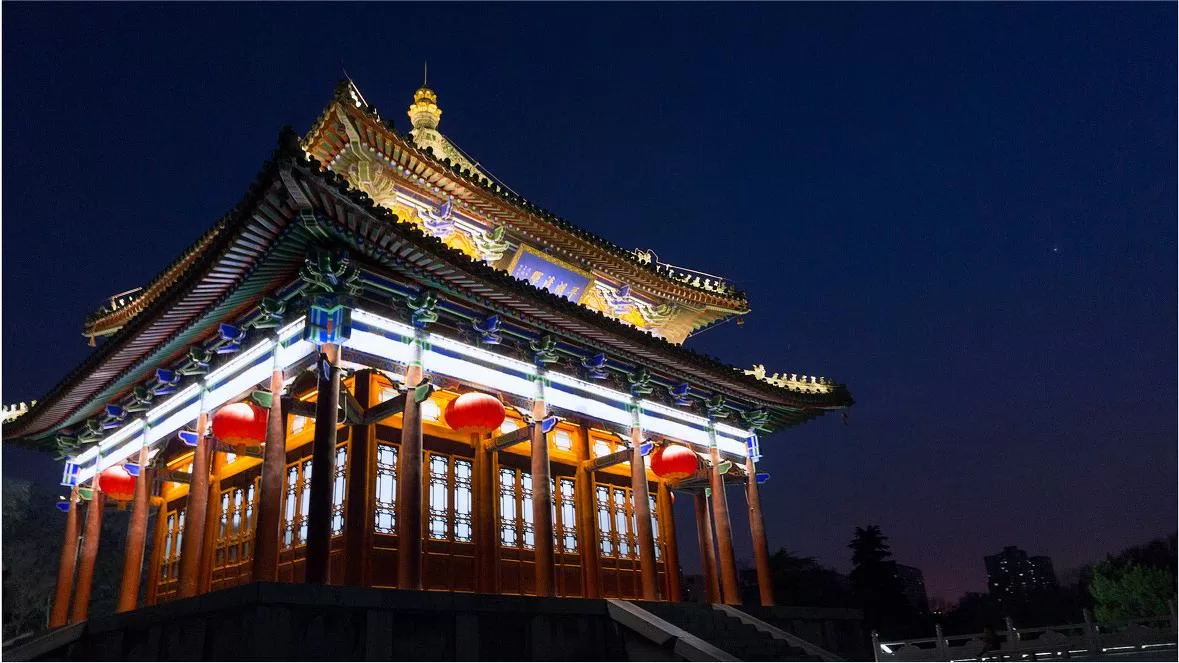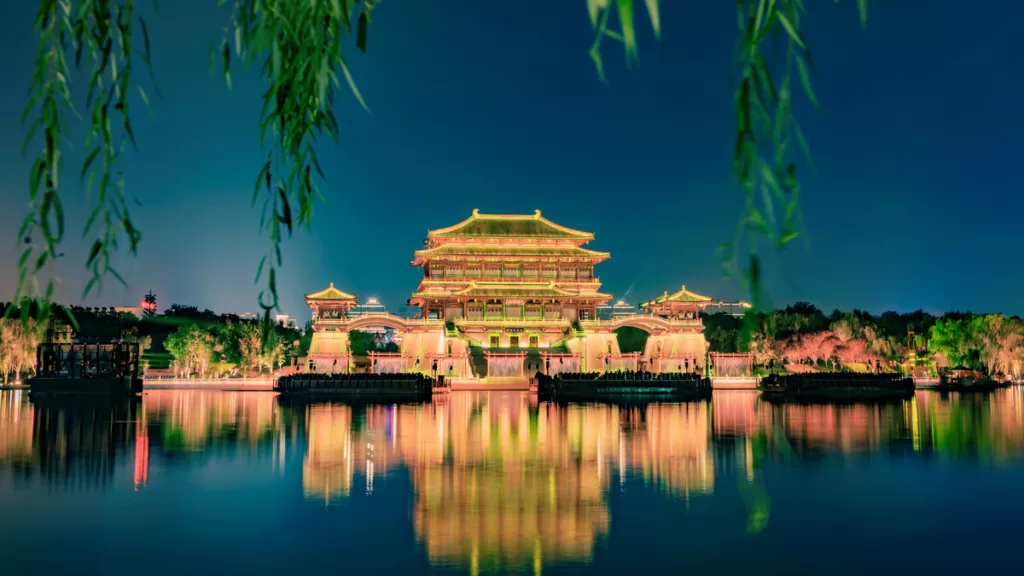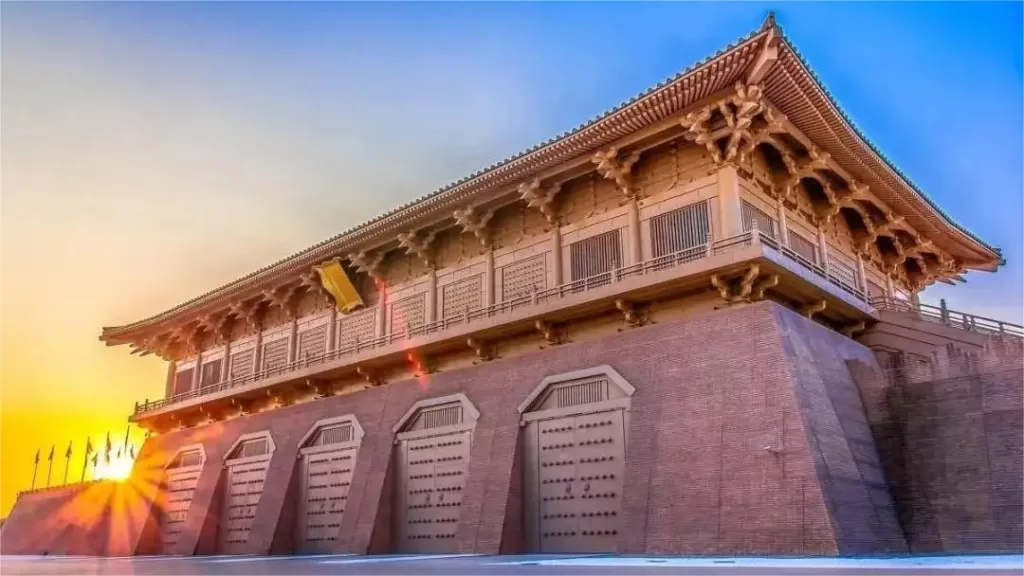Xingqing Palace Park (兴庆宫公园), situated on the ruins of the Tang Dynasty’s Xingqing Palace, is not just a city park in Xi’an, but also a prominent cultural heritage site in China. Facing the park is the renowned Xi’an Jiaotong University, creating a harmonious blend of academia and history. Xingqing Palace was a crucial hub for Tang Xuanzong‘s political activities and the residence of the famous imperial concubine Yang Guifei. Following the tumultuous An Lushan Rebellion, it became the dwelling place for the retired emperor.
The park’s design seamlessly melds traditional Chinese architectural styles with influences from foreign garden design. Centered around Xingqing Lake and following the original layout of the palace, it features attractions like Chenxiang Pavilion, Hua’e Xianghui Pavilion, Nanxun Ge, and Changqing Xuan. A wide variety of plants grace the park, ensuring that each season offers a unique spectacle, with spring’s blooming flowers drawing numerous visitors. This palace, with its rich history, not only showcases its millennia-old legacy and captivating legends but also presents a vibrant and dynamic face to the world.
Table of Contents
- Basic Information
- Location and Transportation
- Highlights of Xingqing Palace Park
- Vlog about Xingqing Palace Park
- History of Qingxing Palace
- Useful Tips Summarized from Reviews
- Other Palaces in Xi’an
Basic Information
| Estimated Length of Tour | About 1 hour |
| Opening Hours | 6.00 – 22.00; Last admission: 21.00 |
| Ticket Price | Free |
| Telephone Number | 0086-029-82485349 0086-029-82495193 |
Location and Transportation
Xingqing Palace is located in the eastern part of Xi’an, Shaanxi Province, China. The specific address is 55 Xianning West Road, Beilin District. You can get there easily by public transport.
Bus: Take bus 8, 15, 37, 102, 300, or 602, get off at Xingqinglu Huzhulu Stop (兴庆路互助路口), and the palace will be right to your south.
Subway: Take subway line 6, get off at Jiaotong University and Xingqing Palace Station (交通大学·兴庆宫站), and the palace will be to your north.
Highlights of Xingqing Palace Park
Imperial Garden

The Imperial Garden in Xingqing Palace is a stunning example of a Tang Dynasty garden. It covers an area of over 3,000 square meters and is a combination of natural landscapes and man-made structures. The garden features pavilions, rock formations, and a central pond with a bridge and was designed to create a peaceful and harmonious environment, with carefully placed elements that promote balance and symmetry. Visitors can stroll along the paths, admire the flowers and trees, and appreciate the intricate details of the garden’s architecture.
Tang Dynasty Wall Murals

Xingqing Palace is home to some of the best-preserved Tang Dynasty wall murals in China, which depict a wide range of subjects, including landscapes, religious scenes, and daily life. The murals are notable for their vivid colors, intricate details, and realistic depictions of people and objects. They provide a valuable insight into the art, culture, and daily life of the Tang Dynasty.
The Palaces

Xingqing Palace, once the political epicenter of the Tang Dynasty, was also the prolonged residence of Emperor Tang Xuanzong and his beloved consort, Yang Yuhuan. The palace complex originally included structures such as Xingqing Hall, Nanxun Hall, Datong Hall, Qinzheng Wuben Building, Hua’e Xianghui Pavilion, and Chenxiang Pavilion. Xingqing Hall served as the place where the emperor met his ministers, while Nanxun Hall was his resting place after court sessions. Datong Hall was where the imperial scholars conducted their official duties. Qinzheng Wuben Building was the main hall of Xingqing Palace, hosting significant ceremonies like imperial era changes, imperial examinations, and amnesties. Hua’e Xianghui Pavilion, also known as Hua’e Pavilion, stood among China’s four great pavilions, alongside Tengwang Pavilion in Jiangxi, Yellow Crane Tower in Hubei, Yueyang Tower in Hunan, and Guanque Tower in Shanxi, collectively known as the “Five Great Towers of the Realm.” Hua’e Pavilion earned the title “The Number One Tower in the World.”
Vlog about Xingqing Palace Park
History of Qingxing Palace
Xingqing Palace, situated in the eastern part of Chang’an (modern-day Xi’an) during the Tang Dynasty, was originally a residence for Tang Emperor Xuanzong (Li Longji) before his ascent to the throne. The palace was located within the Chang’an outer city in the Xingqing Fang area, which was known for its scenic gardens and vibrant urban environment.
Prior to becoming a palace, Xingqing Fang was known as Longqing Fang and served as the residence of Li Longji, who was a prince at that time. He lived there with his brothers, including the Song King, in the prosperous eastern district of Chang’an. This area, referred to as the “Five Princes’ Residence,” was renowned for its gardens and luxurious surroundings.
In 712 AD, Li Longji ascended the throne as Emperor Xuanzong. To avoid using his own name in official titles, he renamed Longqing Fang to Xingqing Fang. The transformation of this area into a palace began in 714 AD when he relocated the residences of his four half-brothers to neighboring areas and officially designated Xingqing Fang as Xingqing Palace.
By 720 AD, significant developments were underway. The palace expanded with the construction of the Huaxue Xianghui Tower and the Qinzhen Wuben Hall in the southwestern section. By 726 AD, the palace complex had been further extended to include parts of the northern Yongjia Fang and western Shengye Fang, becoming the primary site for Xuanzong’s administration, referred to as the “Southern Inner Palace.”
In 732 AD, a new city wall was added on the eastern side of the outer city to connect Xingqing Palace directly with the Daming Palace and Qujiang Pool, enhancing its strategic and administrative importance. Additional walls were constructed to the south of the palace in subsequent years. By 736 AD, the Huaxue Xianghui Tower had been expanded further.
During the Tianbao era (751-756 AD), new structures such as the Jiaotai Hall were added behind the Xingqing Hall. However, after the An Lushan Rebellion in 756 AD, Xingqing Palace lost its status as a political center. It became a residence for the retired emperor or empress dowager and was predominantly occupied by members of the imperial harem.
In the late Tang Dynasty, as Chang’an fell into decline and the city was eventually destroyed, Xingqing Palace was abandoned and fell into disrepair.
In 1955, the Xi’an Municipal Government decided to establish a park on the site of the former Xingqing Palace, naming it Xingqing Palace Ruins Park. By 1957, the Shaanxi Provincial Cultural Relics Administration conducted extensive archaeological investigations, and by early 1958, the Chinese Academy of Sciences Archaeological Institute, in cooperation with the Xi’an Municipal Cultural Relics Administration, excavated the southwestern part of the site, revealing seventeen building ruins.
In 1958, construction began on the Xingqing Palace Ruins Park, which covers an area of 48.6 hectares. The park features reconstructed pavilions, including the Chenxiang Pavilion, Nanxun Pavilion, and the Huaxue Xianghui Tower, and includes water features and landscaped gardens.
From the 1960s to the 1980s, the park underwent further restorations and expansions, increasing its total area to 52.5 hectares, with Xingqing Lake occupying 10 hectares. In preparation for the 14th National Games, held from December 25, 2020, to June 30, 2021, the park underwent significant upgrades, including heritage preservation, Tang Dynasty architectural restorations, water management, and overall landscape enhancement.
Useful Tips Summarized from Reviews
Restrooms: Restrooms are readily available throughout the park, and they are well-maintained and clean. You’ll find them conveniently located so you won’t have to walk far to find one when needed.
Boating Options: Enjoy a leisurely boat ride on the lake within Xingqing Palace Park. You have two options: pedal boats and electric boats. Pedal boats accommodate up to four people and cost 120 yuan for a 40-minute rental. Electric boats come in two sizes, accommodating either four or six people, and cost 160 yuan or 200 yuan respectively for a 40-minute rental. Boating provides a serene and scenic way to explore the park from a different perspective.
Park Entrance: The main entrance to the park is located near the south gate, across from the Xi’an Jiaotong University. Most of the park’s attractions are concentrated near the south gate, with the exception of the Shaanxi Tang Dynasty Art Museum. If you have the energy, consider exploring the park by starting at the south gate and making your way northward around the central island. This route may lead to unexpected discoveries and picturesque views along the way.






The park is huge, with Xingqing Pier (兴庆码头) inside where you can take a boat. The flowers are in full bloom now, so everyone should go and enjoy the blossoms!